
FINGERPRINTS WORLD MAP - Global Distribution of Whorls, Loops & Arches!

MAY 11, 2011 [LAST UPDATES: MARCH, 2015 - New world map added!]
The Fingerprints-World-Map!
In 1953 David C. Rife (Institute of Genetics and Department of Zoology, Ohio State University) presented a fingerprints world map displaying the distribution of the so-called 'pattern index' around the world. What can we learn from this world map today? Is it still valid? A brand new world map presents the answer - in short: sure!
Regarding the global distribution of whorl-, (radial) loop- & arch fingerprints: which is the most common fingerprint type? And what is the most common fingerprint-distribution seen in the 10 fingers? This article describes all details.
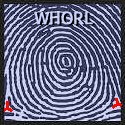
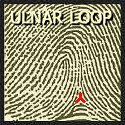
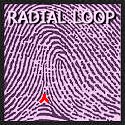

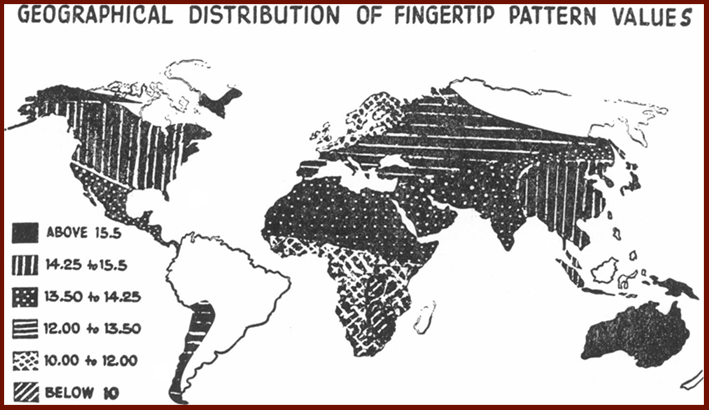
The fingerprint world map according C. Rife (1953) above displays the distrubution of the 'pattern index' (pattern intensity) -
which was defined by Harold Cummins (Cummins and Midlo, 1943) as follows:
"PATTERN INTENSITY. Arches, loops and whorls form a sequence of increasing pattern complexity. This sequence has as its parallel an increase in the number of triradii - the plain arch having none, the loop one, and the whorl two. The number of triradii accordingly is available for a simple quantitative statement of pattern intensity. The value of pattern intensity may be stated either as the number of triradii per indiviual, or as the average number of triradii per finger."
NOTICE: In 1977 W.J. Babler summarized data for about 120 populations around the world; the data presented by Rife (1953) and Babler (1977) has been combined inside the brand new world map that is presented below (only the data for the eskimo populations in northern america varies significantly from the 1943 world map) - click HERE for larger version!
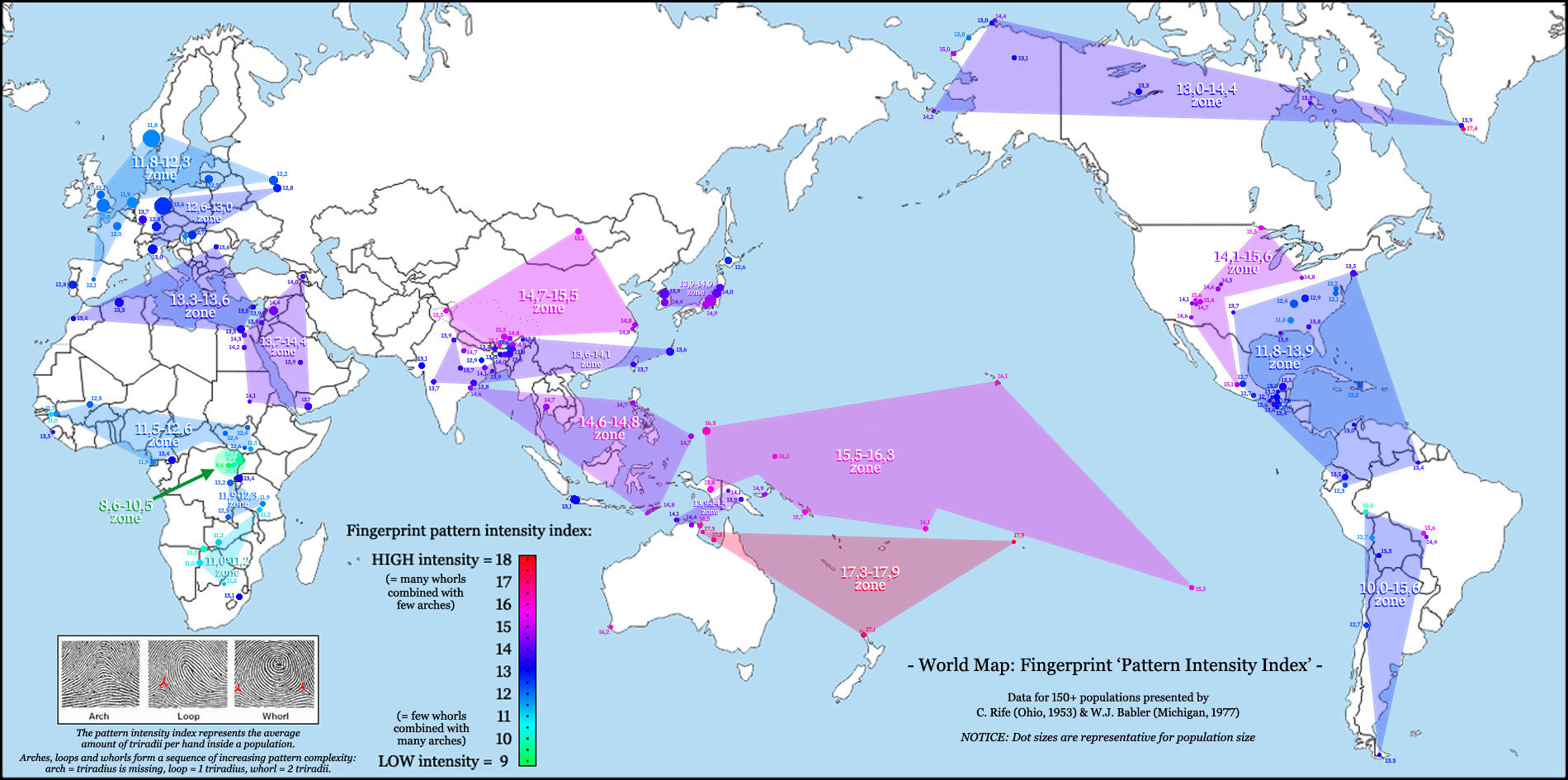
The highest 'pattern intensity index' (see definition between world maps above) in the world is found in populations located in the continent Oceania (including Australia), where endigenous populations usually have a average 'pattern index' above 15.4. Oceanian populations usually have whorls to represent the most common fingerprint category, and in many (east) Asian countries a likewise tendency is seen, while in most other regions around the world loops are clearly most common.
The lowest 'pattern index' in the world is found in populations located in the south of the contient Africa, e.g. in Bushmen & Pygmies are arches likewise commons as whorls - resulting in an average 'pattern index' that may even drop below 10 (while in nearly all populations around the world whorls are always much more common than arches).
The continuation of this article answers the following questions:
• What are the most important fingerprint types?
• Which is the most common fingerprint type in the world?
• What is the most common fingerprint distribution in the 10 individual fingers?
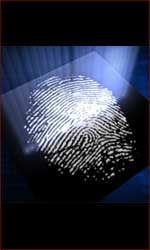
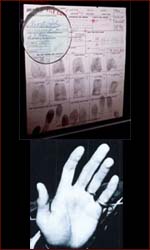
What are the most important fingerprint types?
The most well-known system for fingerprint classification was presented by the F.B.I. in 1985, titled: "The Science of Fingerprint".
The F.B.I. system describes 8 types of fingerprints: 2 arch variants (plain arches & tented arches), 2 loop variants (ulnar loops & radial loops), and 4 whorl variants (plain whorls, central pocket loops, double loops & accidental whorls) - see picture below.
Since 1985 researchers have continued to use various other approaches to classify the most common fingerprint variants.
Usually the 4 most common variants of these 8 types are recognized to represent the major categories (arches, radial loops, ulnar loops & whorls).
Because these 4 most common variants are relatively easy to discriminate from eachother, the continuation of this article is focussed on the prevalence of these 4 major variants around the world.
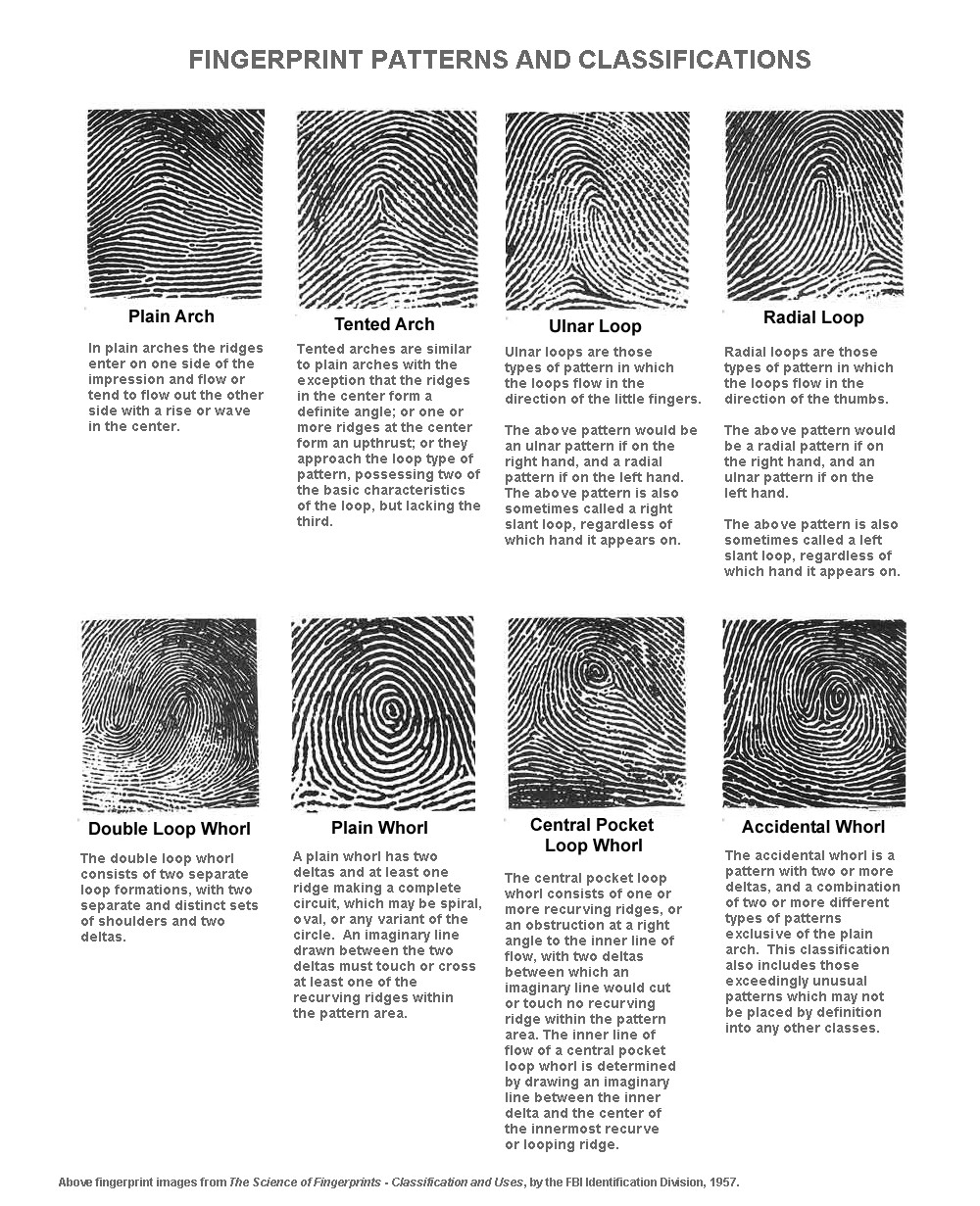
Which is the most common fingerprint type in the world?
The tables below display various aspects of fingerprint distributions for 32 countries around the world; in 28 out 33 populations (ULNAR) LOOPS represent the most common fingerprint pattern category. Outside Oceanie only the populations from China & Malaysia show a tendency for WHORLS to be more common than LOOPS - which confirms the tendencies seen in the two fingerprint world maps (presented at the top of this article).
Regarding the 1943 world map the 'pattern index' for Botswana, China, Ellice Islands, France, India, Israel, Kenya, Korea, Malaysia, The Netherlands, New Zealand (Maoris), Nigeria, Russia, Tanzania & Yemen is exactly within the expected range;
and for Algeria, Costa Rica, England, Guatemala, Iran, Iraq, New Guinea, Sri Lanka, Sweden, Thailand, Venezuela & Vietnam it is (very) close to the expected range.
For Indonesia, Japan & Korea the values are clearly below (though not far away) the expected range; the 'pattern index' for the US is significantly lower and not meeting the expectations according the 1953 map, but it does meet the tendency seen in the 1977 world map. Only for Argentina (& Malaysia) the value is much higher than then tendeny displayed by both the 1943 en 1977 world map.
And as expected:
- the highest 'pattern index' is found in Oceanie: Ellice Islands, New Guinea, New Zealand (Maori);
- all reported countries in the south of Africa (Botswana, Kenya & Tanzania) present results that clearly show a low 'pattern index'.
NOTICE: Interestingly, only for the populations from Argentina, England, Guatemala the 'pattern intensity index' is (slightly) higher than the expected range; but in many countries the 'pattern index' is lower than expected.
This could indicate... that during the past decades the percentage of 'whorls' has become slightly smaller in many populations around the world - as whorls have the highest weight in the 'pattern index'!
However, there is no clear evidence that this tendency is more obvious for the more recent samples (4 out of 9 samples in the 21 century still follow the guidelines presented in the map, but none of the other 5 samples is higher than the expected range: all those 5 samples are lower).
When this tendency is confirmed in the future this could make sense in the perspective of Darwin's evolution theory - because WHORLS are already are recognized to be less common in humans than in primates!
CONCLUSION:
The reported results around the world (below) show a very high correlation with the 1953 & 1977 fingerprint world maps!
The percentages indicate that LOOPS (ulnar + radial) are seen in a majority (50%) of all fingers around the world; this tendency is sort of confirmed in 28 out of the 33 populations.
WHORLS are only sometimes more common than loops; only 5 out of 33 populations have more WHORLS than LOOPS, but for WHORLS the percentage only in 4 populations higher than 50%, for: Ellice Island, New Guinea, New Zealand (Maoris) & Malaysia.
Finally, it is remarkable that almost half of the populations show (clearly) lower percentages than expected according the 1953 Fingerprint World Map.
Only a few of the older samples (Argentina sample from 1978, England: samples from 1943, 1964 & 1983) show percentage above the expected range according the map.
NOTICE: Countries in the tables below are ranked by 'PATTERN INTENSITY INDEX'; 'double loop whorls', 'plain whorls', 'central pocket loop whorls' and 'accidental whorls' are grouped as WHORLS; and 'plain arches' & 'tented arches' grouped as ARCHES.




![]() Ellice islands (N=114) 1; PI = 16,65:
Ellice islands (N=114) 1; PI = 16,65:![]() Maori of New Zealand (N=216) 2; PI = 16,64:
Maori of New Zealand (N=216) 2; PI = 16,64:![]() New Guinea (N=166) 3; PI = 15,45:
New Guinea (N=166) 3; PI = 15,45:![]() Malaysia (N=48) 4; PI = 15,35:
Malaysia (N=48) 4; PI = 15,35:![]() China (N=693) 5a-b; PI = 14,48:
China (N=693) 5a-b; PI = 14,48:![]() Guatemala (N=100) 6; PI = 14,40:
Guatemala (N=100) 6; PI = 14,40:![]() Argentina (N=60) 7; PI = 14,38:
Argentina (N=60) 7; PI = 14,38:![]() Korea (N=6.141) 8a-b; PI = 14,25:
Korea (N=6.141) 8a-b; PI = 14,25:![]() Thailand (N=2202) 9a-b; PI = 14,14:
Thailand (N=2202) 9a-b; PI = 14,14:![]() Vietnam (N=135) 10; PI = 14,06:
Vietnam (N=135) 10; PI = 14,06:![]() Israel (N=1126) 11a-b; PI = 13,66:
Israel (N=1126) 11a-b; PI = 13,66:![]() India (N=455) 4,12a-b; PI = 13,58:
India (N=455) 4,12a-b; PI = 13,58:![]() Yemen (N=240) 13; PI = 13,53:
Yemen (N=240) 13; PI = 13,53:![]() Iran (N=200) 14; PI = 13,39:
Iran (N=200) 14; PI = 13,39:![]() Iraq (N=107) 6; PI = 13,38:
Iraq (N=107) 6; PI = 13,38:![]() Indonesia (N=2000) 8b; PI = 13,13:
Indonesia (N=2000) 8b; PI = 13,13:![]() Sri Lanka (N=434) 15; PI = 13,07:
Sri Lanka (N=434) 15; PI = 13,07:![]() Russia (N=547) 16; PI = 12,89:
Russia (N=547) 16; PI = 12,89:![]() Algeria (N=250) 17; PI = 12,88:
Algeria (N=250) 17; PI = 12,88:![]() Brazil (N=300) 18; PI = 12,59:
Brazil (N=300) 18; PI = 12,59:![]() Sweden (N=120.000) 19; PI = 12,21:
Sweden (N=120.000) 19; PI = 12,21:![]() England (N=6.300) 20a-c; PI = 12,07:
England (N=6.300) 20a-c; PI = 12,07:![]() Poland (N=300) 20c; PI = 12,00:
Poland (N=300) 20c; PI = 12,00:![]() France (N=76) 21; PI = 11,99:
France (N=76) 21; PI = 11,99:![]() US (N=1027) 22a-c; PI = 11,92:
US (N=1027) 22a-c; PI = 11,92:![]() Norway (N=24.518) 23; PI = 11,83:
Norway (N=24.518) 23; PI = 11,83:![]() Netherlands (N=2.500) 24; PI = 11,81:
Netherlands (N=2.500) 24; PI = 11,81:![]() Nigeria (N=1216) 25a-b; PI = 11,57:
Nigeria (N=1216) 25a-b; PI = 11,57:![]() Kenya (N=304) 26; PI = 11,42:
Kenya (N=304) 26; PI = 11,42:![]() Tanzania (N=300) 26; PI = 11,40:
Tanzania (N=300) 26; PI = 11,40:![]() Costa Rica (N=743) 27; PI = 11,01:
Costa Rica (N=743) 27; PI = 11,01:![]() Venezuela (N=119) 28; PI = 10,53:
Venezuela (N=119) 28; PI = 10,53:![]() Botswana (N=345) 8b; PI = 9,97:
Botswana (N=345) 8b; PI = 9,97:
* Percentages are derived from a continental variation analysis.
NOTICE: Seven out of the 10 most populous countries in the world today are represented in the table above. For Brazil, India, Nigeria & Russia the statistics are within the expected range according the 1953 Fingerprint World Map, but for almost half of these most populous countries (China, Japan & US) the statistics indicate that the number of WHORLS might have dropped there during the past decades; all data together involves 172,673 subjects.
Sources:
1) Polynesian Finger Prints: Ellice Islanders
(A. M. O. Veale and W. E. Adams, 1968);
2) Finger-Prints of the New Zealand Maori (A. M. O. Veale and W. E. Adams, 1965);
3) Dermatoglyphics of the Fore and Anga populations of the Eastern Highlands of New Guinea (C.C. Plato & D.C. Gajdusek, 1972);
4)Dermatoglyphics: comparison between Negritos Orang Asliand the Malays, Chinese and Indian (E. Ismail et al., 2009);
5a) Dermatoglyphic changes during the population admixture between Kam and Han Chinese (Xu Cheng et al., 2009);
5b) Dermatoglyphs of Chinese children with Down syndrome (J.I. Bryant et al., 1970);
6) Inferring Individual to Group Associations for Endogamous Populations using Dermatoglyphic Characteristics. (D.W. Herdegen, 2012);
7) Dermatoglyphics: An International Perspective (J. Mavalwala, 1978);
8a) Dermatoglyphic Characteristics of Patients with Rheumatoid Arthritis (Sung-Bae Hwang et al., 2005);
8b) Dermatoglyphic traits in Koreans. (K.-S. Park & H.Y. CHeon, 1984);
9a) Dermatoglyphic Traits in Thai Schizophrenia Patients: A Matching Case-Control Study (Suwanna Arunpongpaisal et al., 2011);
9b) An Exploration of Fingerprint Patterns and Their
Concordance Among Thai Adolescents (S. Nanakorn, W. Kutanan & K. Chusilp, 2013);
10) Dermatoglyph groups Kinh Vietnamese to Mon-Khmer (Hui Li et al., 2006);
11a) Dermatoglyphic sexual dimorphism in Middle Eastern Jews (S. Micle & E. Kobyliansky, 1987);
11b) Relationship between genetic anomalies
of different levels and deviations in dermatoglyphic traits. (E. Kobyliansky et al., 2004);
12a) Finger Dermatoglyphic variations in Rengma Nagas of Nagaland India (S.D. Banik et al., 2009);
12b) Study of the Fingertip Pattern as a Tool for the Identification of the Dermatoglyphic Trait in Bronchial Asthma (S.V. Pakhale et al., 2012);
13) Dermatoglyphic sexual dimorphism in Yemenite Jews (S. Micle & E. Kobyliansky, 1987);
14) A study of Iranaian Muslims - Part 1: Finger patterns and ridge-counts (M. Mehdipour & D.D. Farhud, 1978);
15) Sexual dimorphism in digital dermatoglyphic
traits among Sinhalese people in Sri Lanka (B.T.W. Wijerathne, 2013);
16) Qualitative finger and palmar dermatoglyphics: sexual dimorphism in the Chuvasian populations of Russia. (B. Kamakar et al., 2007);
17) Caractérisation anthropogénétique de la population de Msirda (Nord Ouest algérien) sur la base de l'analyse du polymorphisme des Dermatoglyphes digitaux. (N. Mortad et al., 2012);
18) Dermatoglyphic in a large normal sample of Caucasoids from Southern Brazil (E. de F. Penhalber et al., 1994);
19) A Swedish method of fingerprint classification (A. Rignell & K.E. Sjöqvist, 1983);
20a) Finger prints, Palms and Soles (H. Cummins & C. Midlo, 1943);
20b) Fingerprint-patterns in mongolism (S. Holt, 1964);
20c) Quantitative Dermatoglyphics (D.Z. Loesch, 1983);
21) Dermatoglyphic patterns in dementia of the Alzheimer type: a case-control study (C. Berr et al., 1992);
22a) The use of dermal configurations in the diagnosis of mongolism (F. Walker, 1958);
22b) Dermatoglyphics in Medical Disorders (B. Schaumann & M. Alter, 1976);
22c) An Information and Discriminant Analysis of Fingerprint
Patterns Pertaining to Identification of Mongolism and Mental Retardation (K.H. Lu, 1967);
23) Studies in papillary patterns in human fingers (K. Bonnevie, 1924) (Reported in: On the Formation of Fingerprints (M. Kuecken, 2004);
24) Vingerlijsten - Het Lot in Eigen Hand, in: Natuur & Techniek (4) (A.G. de Wilde, 1986);
25a) A study on the dermatoglyphic patterns of Okrika and Ikwerre ethnic groups of Nigeria (E.A. Osunwoke et al., 2008);
25b) Palmar dermatoglyphics of Nigerians residing in Lagos - Nigeria. (A.D. Abue et al., 2013);
26) Palmar and digital dermatoglyphic traits of Kenyan and Tanzanian subjects (P.S. Igbigbi & B.C. Msamati, 2005);
27) Dermatoglyphic traits of six Chibcha-speaking Amerindians of Costa Rica, and an assessment of the genetic affinities among populations (Maia Segura - WW Ramiro Barrantes, 2009);
28) Dermatoglyphics in two Yukpa groups from the Sierra de Perijá: Chaparro and Rarirí (A.G de Díaz Ungría, 1978).
What is the most common fingerprint distribution in the 10 fingers?
The distribution of fingerprint types varies significantly among individual fingers.
In order to identify the most typical distribution in among the 10 fingers, we can simply take a look at the most common fingerprint pattern type in each of the 21 populations.
The table below presents an overview of the most common fingerprint types on each of the 10 fingers.
NOTICE: The table below displays the most common fingerprint types for each single finger among the 21 international populations.
| COUNTRY | FINGER |
FINGER |
FINGER |
|||
left |
W |
W |
W |
W |
W |
|
left |
W |
W |
W |
W |
W |
|
left |
W |
W |
W |
W |
UL |
|
|
|
||||||
left |
W |
W |
W |
W |
W |
|
left |
W |
W |
UL |
W |
UL |
|
left |
W |
W |
UL |
W |
UL |
|
left |
W |
UL |
UL |
W |
UL |
|
left |
W |
W |
UL |
W |
UL |
|
left |
W |
W |
UL |
W |
UL |
|
left |
UL |
UL |
UL |
W |
UL |
|
|
|
||||||
left |
W |
W |
UL |
W |
UL |
|
left |
W |
W |
UL |
W |
UL |
|
left |
UL |
W |
UL |
W |
UL |
|
left |
W |
W |
UL |
W |
UL |
|
left |
UL |
W |
UL |
UL |
UL |
|
left |
UL? |
W?? |
UL |
W? |
UL |
|
left |
UL |
W |
UL |
W |
UL |
|
|
|
||||||
left |
UL |
UL |
UL |
UL |
UL |
|
left |
W |
UL |
UL |
UL |
UL |
|
left |
UL |
W |
UL |
UL |
UL |
|
|
|
||||||
left |
UL |
UL |
UL |
UL |
UL |
|
left |
UL |
UL |
UL |
UL |
UL |
|
left |
UL |
UL |
UL |
UL |
UL |
|
left |
UL |
UL |
UL |
UL |
UL |
|
left |
UL |
UL |
UL |
UL |
UL |
|
left |
UL |
UL |
UL |
UL |
UL |
|
left |
UL |
UL |
UL |
UL |
UL |
|
|
|
||||||
left |
UL |
UL |
UL |
UL |
UL |
|
left |
UL |
UL |
UL |
UL |
UL |
|
left |
UL |
UL |
UL |
UL |
UL |
|
|
|
||||||
left |
UL |
UL |
UL |
UL |
UL |
|
left |
W |
UL |
UL |
UL |
UL |
|
|
|
||||||
left |
UL |
UL |
UL |
UL |
UL |
|
|
|
||||||
| THE UNIVERSAL DISTRIBUTION FOR THE 10 FINGERS: | left |
W* |
W* |
UL* |
W* |
UL* |
* Resulting from weights according world population statistics in the year 2000.
The results in the table show that in all populations in each of the 10 fingers the ulnar loop or the whorl is always the most common fingerprint pattern type in any country around the world.
In both the right hand and the left hand the ulnar loop on the pinky is found in a large majority of 21 out of 23 populations; this trend is only not seen New Zealand Maori and Ellice Islands people. A likewise trend is seen in the middle finger, though in the populations of New Zealand Maori, Ellice Islands and New Guinea the whorl is more common on the middle finger of both hands.
This makes the whorl the most dominant pattern on the ring finger, the thumb & and the index finger in far most populations .
Interestingly, this also implicates that a common similarity between the 23 populations is a high prevalance of the so-called 'universal distribution' for the 10 fingers:
Right hand (thumb to pinky):__ whorl - whorl - ulnar loop - whorl - ulnar loop;
Left hand (thumb to pinky):___ whorl - whorl - ulnar loop - whorl - ulnar loop.
Usually this distribution belongs to the TOP 10 most common fingerprint combinations seen around the world:
- 3th position (6.2%) in an Ellice Islanders (N=114), where W-W-W-W-W (30.8%) is extremely dominant;
- 5th position (4.7%) in an American sample (N=299), where UL-UL-UL-UL-UL (15.5%) is by far most common;
- 7th position (4.0%) in a Dutch sample (N=300), where UL-UL-UL-UL-UL (17.0%) is by far most common;
- 7th position (3.7%) in a Thai study (N=2134), where UL-UL-UL-UL-UL (11.2%) is most common;
- 8th position (3.2%) in a British sample (N=600), where UL-UL-UL-UL-UL (17.3%) is by far most common;
- 11th position (2.4%) in New Zealand Maori (N=216), where W-W-W-W-W (31.7%) is extremely dominant.
NOTICE: In all 6 of these populations the 'universal distribution' turns out to have a prevalence above 2%, and only two other combinations (UL-UL-UL-UL-UL & W-UL-UL-UL-UL) also score above 2% in all 6 populations; however, usually both the UL-UL-UL-UL-UL and W-W-W-W-W combination have a higher prevalence that the W-W-UL-UL-W combination!
So, the 'universal distribution' clearly should not be taken to represent the most common distribution around the world; because various studies indicate that UL-UL-UL-UL-UL represents very likely by the most common distribution in far most countries, on top of this only in a very small number of countries W-W-W-W-W represents the most common combination.
Finally, it is interesting to notice that both the 'white' (and 'black') populations shows by far the largest variation compared to this 'universal distribution':
- the population from the USA displays differentations on five aspects;
- the populations from UK & The Netherlands display differentiations on six aspects;
(- the populations from Kenya, Tanzania & Costa Rica also display differentiations on six aspects)




Finally, one should also consider the normal distribution of the four pattern types: radial loops are typically seen on the index finger only, while arches are typically seen on the index finger and/or middle finger only + in neighbour-combinations with one of these two fingers.
Read more about: the role of fingerprints & dermatoglyphics in Multi-Perspective Palm Reading.
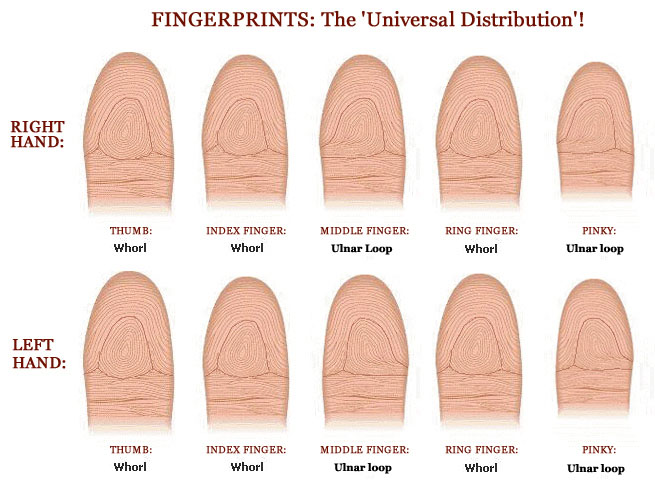
Related sources:
Fingerprint distributions & hand diagnostics!
10 Facts about radial loop fingerprints!
10 Facts about arch fingerprints!
Dermatoglyphics Multiple Intelligences Test: review
The function of the hand: dermatoglyphics, fingerprints, creases, lines & nails
The 4th IBMBS Conference takes place in October 2009!
How fingerprinting works
Dermatoglyphics: a review
Fingerprints & Psychological Patterns of Personality
Palmistry: a science in process
The fingerprints world map: the distribution of whorls, loops & arches!
![]() FINGERPRINTS INDEX:
FINGERPRINTS INDEX:
INTRO: Fingerprints & Hand Diagnostics
• HISTORY of Fingerprints
• CLASSIFICATION of Fingerprints
• SEXE DIFFERENCES & Fingerprints
• ETHNIC DIFFERENCES & Fingerprints
• DISEASES & Fingerprints
• Fingerprints & BEHAVIOR!
• FINGERPRINT DISTRIBUTIONS on the 5 Fingers
• WORLD MAP of Fingerprints
• 10 Facts about radial loop fingerprints
• 10 Facts about arch fingerprints
• MORE NEWS about Fingerprints
• Dermatoglyphics Multiple Intelligence Test